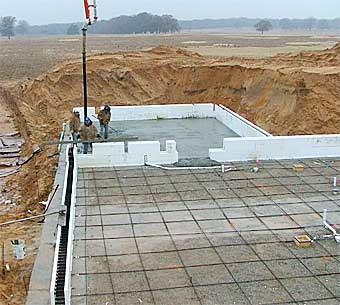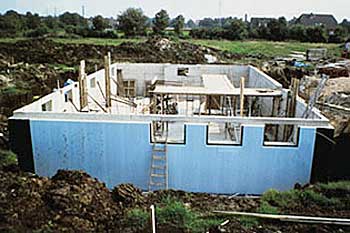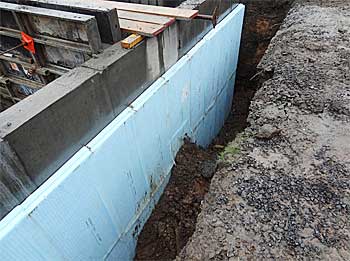Insulating
Underground Homes
Insulating underground or earth-sheltered homes is a
vital step in the construction process. A lack of the
proper amount and type of insulation leads to conditions
that can make the home uninhabitable, such as a buildup
of mold and mildew.
 Insulating an underground home
Insulating an underground home |
|
Waterproofing and improving air quality in an earth-sheltered
home go hand in hand with proper insulation. All three
factors must be done to meet construction standards.
Underground homes are classified according to their construction.
A structure whose topmost feature sits below the surrounding
surface is considered a full-fledged underground home.
The other two types are very similar to one another. An
earth-bermed home is one that has had soil banked around
one or more of its walls and possibly over its roof. An
in-hill home is built into a hill, with only one of its
walls visible outside.
Protection by Reduction ...
Choosing to build an earth-sheltered home has the advantage
of reducing the amount of energy required to keep the
interior temperature comfortable. It is especially useful
in areas where the climate tends to gravitate toward the
extremes of hot and cold for reducing heating and cooling
costs. From an aesthetics perspective, it blends in with
the surrounding terrain. It reduces noise and the house
is better protected from bad weather, natural and man-made
disasters.

Underground Home Insulation
What the Sheet?
Earth-sheltered homes will usually have either close-celled
extruded polystyrene sheets or spray-on foam as insulation.
Polystyrene is efficient by itself, utilizing a few layers
on the exterior of the structure. For structures that
do not follow a standard design, the spray-on foam is
the preferred material. However, foam requires an extra
material on top of it to protect it from time and weather.
In some instances, underground homes may not be insulated
at all. For these situations, the soil below the surface
is considered efficient enough at retaining the necessary
heat.
Sufficient insulation will ensure that the home remains
a comfortable temperature throughout the year. Mold and
mildew can develop as a complication when the home has
not been properly insulated and waterproofed. Insulation
helps keep moisture caused by humidity from creating such
problems. Otherwise, the air quality of the home is compromised.

Earth Home Insulation Wall
Just Say No to Retrofitting ...
A substantial amount of insulation is worth the extra
effort, as are sealants, in waterproofing and insulating
the structure because it is difficult and costly to fix
any problems with it once the house is completed. Waterproofing
material may be placed on both sides of the insulating
material when foam is used. Anything that has the potential
to leak, including seams, should receive extra attention
and insulation. Even with these precautions, cracks and
leaks can occur. The interior of the house may still have
extra humidity. Using a dehumidifier is a good precaution
to take.
Another possibility for insulating an underground structure
is to use the insulating material in an umbrella design.
It is formed by placing insulating material above the
underground roof of the structure. Domed houses present
an excellent reason to choose this method. The insulation
should be large enough to cover not only the dome, but
also extend past the structure on all sides for a few
feet to increase the insulated area.
Conclusion
Regardless of what type of material is chosen, insulating
underground homes is an important step that should be
included in the planning and construction process.
Written by Kevin Knatloa
First Published on November 05, 2012
Updated November 22, 2013
References
http://en.wikipedia.org/wiki/Earth_sheltering
http://www.monolithic.com/stories/underground-homes-good-or-bad
http://www.norishouse.com/PAHS/UmbrellaHouse.html
|